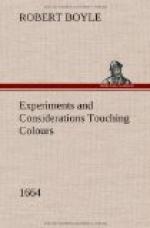to very Minute parts, it thereby requires a Multitude
of Little Surfaces within a Narrow compass. And
though each of these should not be of a Figure Convenient
to Reflect a Round Image of the Sun, yet even from
such an Inconveniently Figur’d body, there may
be Reflected some (either Streight or Crooked) Physical
Line of Light, which Line I call Physical, because
it has some Breadth in it, and in which Line in many
cases some Refraction of the Light falling upon the
Body it depends on, may contribute to the Brightness,
as if a Slender Wire, or Solid Cylinder of Glass be
expos’d to the Light, you shall see in some part
of it a vivid Line of Light, and if we were able to
draw out and lay together a Multitude of these Little
Wires or Thrids of Glass, so Slender, that the Eye
could not discern a Distance betwixt the Luminous Lines,
there is little doubt (as far as I can guess by a
Tryal purposely made with very Slender, but far less
Slender Thrids of Glass, whose Aggregate was Look’d
upon one way White) but the whole Physical Superficies
compos’d of them, would to the Eye appear White,
and if so, it will not be always necessary that the
Figure of those Corpuscles, that make a Body appear
White, should be
Globulous. And as for
Snow it self, though the Learned
Gassendus (as
we have seen above) makes it to seem nothing else but
a pure Frozen Froth, consisting of exceedingly Minute
and Thickset Bubbles; yet I see no necessity of Admitting
that, since not only by the Variously and Curiously
Figur’d Snow, that I have divers times had the
Opportunity with Pleasure to observe, but also by
the Common Snow, it rather doth appear both to the
Naked Eye, and in a
Microscope, often, if not
most commonly, to consist principally of Little Slender
Icicles of several Shapes, which afford such Numerous
Lines of Light, as we have been newly Speaking of.
12. Sixthly, If you take a Diaphanous Body, as
for instance a Piece of Glass, and reduce it to Powder,
the same Body, which when it was Entire, freely Transmitted
the Beams of Light, acquiring by Contusion a multitude
of Minute Surfaces, each of which is as it were a Little,
but Imperfect Speculum, is qualify’d
to Reflect in a Confus’d manner, so many either
Beams, or Little and Singly Unobservable Images of
the Lucid Body, that from a Diaphanous it Degenerates
into a White Body. And I remember, I have for
Trials sake taken Lumps of Rock Crystal, and Heating
them Red hot in a Crucible, I found according to my
Expectation, that being Quench’d in Fair water,
even those that remain’d in seemingly entire
Lumps exchang’d their Translucency for Whiteness,
the Ignition and Extinction having as it were Crack’d
each Lump into a multitude of Minute Bodies, and thereby
given it a great multitude of new Surfaces. And
ev’n with Diaphanous Bodies, that are Colour’d,
there may be this way a Greater Degree of Whiteness
produced, than one would lightly think; as I remember,
I have by Contusion obtain’d Whitish Powders
of Granates, Glass of Antimony, and Emeralds
finely Beaten, and you may more easily make the Experiment,
by taking Good Venereal Vitriol of a Deep Blew,
and comparing with some of the Entire Crystalls purposely
reserv’d, some of the Subtile Powder of the same
Salt, which will Comparatively exhibit a very considerable
degree of Whitishness.




